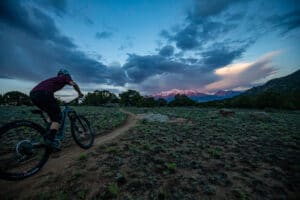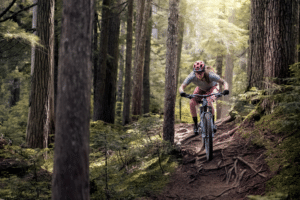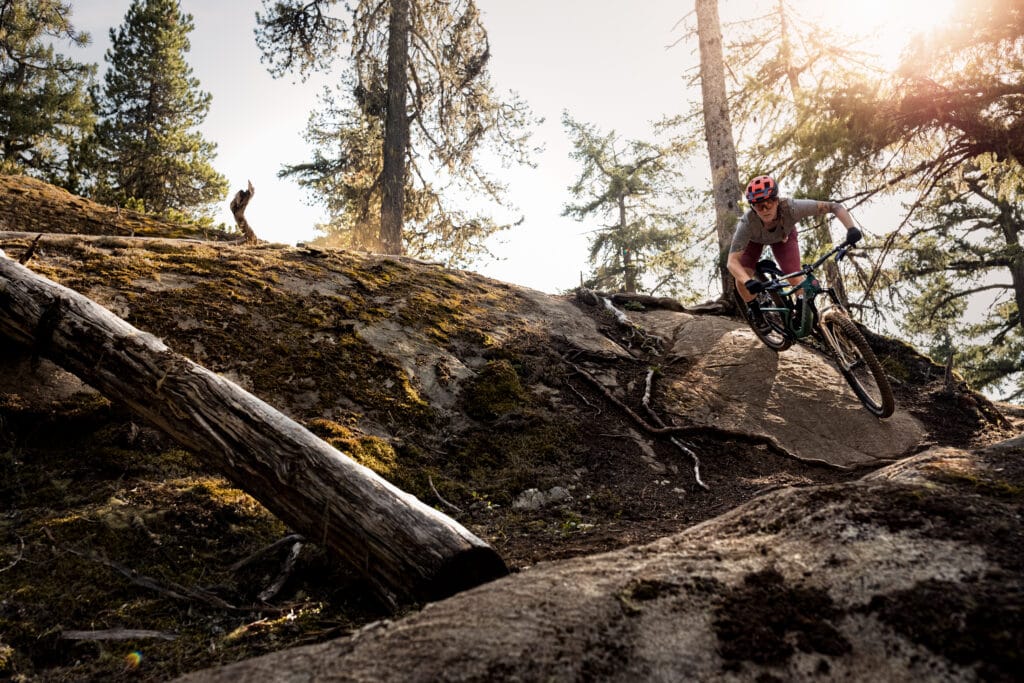If you are new to mountain biking or an experienced rider, there is a lot to consider when choosing a mountain bike. New technology for mountain bikes is constantly evolving components like geometry, gear ratios, and wheel sizes.
It’s always handy to know what to look for when it comes to finding the right mountain bike, so check out our guide on choosing the mountain bike that’s right for you. We’ll be covering:
Types of Mountain Bikes
Trail Bikes
Trail bikes are the most common style of mountain bike. It’s not grounded in any specific type of racing. This is simply ‘mountain biking’ to many and will 
This type of mountain bike sits somewhere between a bike designed for cross country and Enduro racing. Trail bikes are designed to perfectly balance both climbing and descending – a jack of all trades if you will. Bikes in this category place equal emphasis on fun, efficiency and sensible overall weight.
Given the extensive range of trails, you can encounter, a drivetrain with a large gear range is something to look for.
Typical specs: 120–140 mm of suspension travel; 67–69° head-tube angle
Suspension travel is the amount of movement offered by the bike’s front and rear suspension. Head-tube angle is the angle that the head tube forms with the ground.
A steeper head-tube angle generally indicates that a bike will turn faster and climb better. A slacker (lower) angle generally indicates that a bike will provide better stability at high speeds but won’t climb as well.
Enduro Bikes
The objective of enduro biking is speed. Like cross-country trails containing twists and snaking routes, enduro trails usually run straight down through the mountain
Typical specs: 170–200+ mm of suspension travel; 63–65° head-tube angle
Mountain Bike Features
The type of suspension and diameter of the wheel are two key attributes that determine the type of terrain which a bike can handle. While you narrow down your bike options, you’ll also want to consider things like frame design, the number of gears, and type of brakes.
Mountain Bike Suspension Types
Rigid
“Rigid” mountain bikes don’t feature any suspension. The pedals are the driving force of this ride experience and with minimal suspension, pedaling will be extremely efficient and super lightweight. These are easy to maintain and typically less costly but, for greater comfort, most riders prefer bikes with suspension.
Hardtail
A hardtail frame has a suspension fork at the front to help absorb impact on the front wheel, but there is no suspension on the rear of the bike, hence the name hardtail. Typically, hardtails are less expensive than full-suspension bikes and have fewer moving parts which often leads to less maintenance. Many hardtails will lock out the front fork during times when a completely rigid bike is required.
These mountain bikes allow more direct power transfer between the pedal stroke and the rear tire. You can also be at home with a hardtail bike on all-mountain trails, making them a solid option for everything except serious lift-serviced downhill trails because of the lower cost and easier maintenance.
Full/Dual suspension
A full suspension system is found in all categories of mountain bikes. The two suspension systems work together to give the rider a balanced platform that can handle a variety of terrain. It significantly reduces the impact on the driver, increases stability and allows for a more comfortable and forgiving journey.
A full suspension bike can soak up a lot of trail bumps and noise, but when climbing uphill, the bike can also “bob” a little and you lose some of the energy transfer. As a result, most full-suspension models have the ability to lock out the rear suspension in order to offer better power transfer and better climbing.
Mountain Bike Wheel Size
26”
The 26” is inherently lighter and stronger than a bigger wheel. It’s highly maneuverable and easy to find spares. However, it’s easier for rough terrain to slow or even stop the wheels.
27.5” (650b)
These wheels roll rough ground better than the 26”, without the weight and clumsiness of the 29”. There’s a bigger contact patch for more grip and they are almost as maneuverable as the 26”, but with more stability.
29”
29″ wheels are a little slower to accelerate, but you can conquer terrain far easier once you start moving. They are more efficient for longer rides as they keep up their momentum and have a higher “attack angle” which makes the wheel roll more easily over obstacles.
24”
Mountain bikes for children generally have 24” wheels to match children’s shorter legs. The majority are lower-cost versions of adult bikes with simpler components. These usually fit kids between the ages of 10 and 13, but that depends more on the child’s size. Younger, smaller children can get started on mountain bikes with smaller wheels.
Mountain Bike Sizes
Obtaining the correct frame size for your mountain bike is vital. A bike that fits well and suits your height is a bike that you will love to ride. To help you manage more difficult and demanding runs, a properly fitted 
Mountain bikes come in standard sizes (S, M, L) and are similar across brands. Sizes correspond to your height. If you’re in between sizes and are planning on riding hard, you might want the smaller size rather than the larger one – bailing will be easier when things go wrong.
Get the Best Fit in Store
Ready with a general sense of what kind of bike you’re looking for, it’s now a good time to head to a specialty bike store, like Base Camp Cyclery, to check out a few bikes. This is the easiest way to find your perfect fit.
Go for a few test rides of different bikes. You should be able to narrow down your selection to two or three bikes with the help of a sales specialist. If you want to get a better feel for a bike, you can take it out for a demo at Base Camp Cyclery. You want to feel like the bike is a natural extension of your body.
Mountain Bike Maintenance
Any bike purchased from Base Camp Cyclery receives Lifetime Free Adjustments with one complimentary Basic Tune. Bike purchases include a fitting and suspension set up as well as a new bike orientation.
If you purchased a bike elsewhere and would like us to assemble it, we have a new bike assembly with the shop warranty for purchase. We will treat the bike as if it came from our store. This includes Lifetime Free Adjustments with one complimentary Basic Tune. New bike assembly with the Base Camp Cyclery shop warranty also includes fitting and suspension set up with a new bike orientation.
Be sure to bring your bike in to take advantage of these great deals! Contact Base Camp Cyclery for more information and to find your perfect ride.

